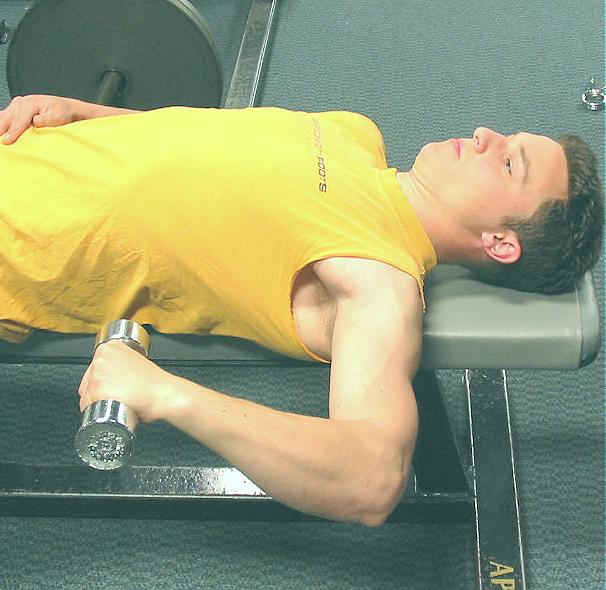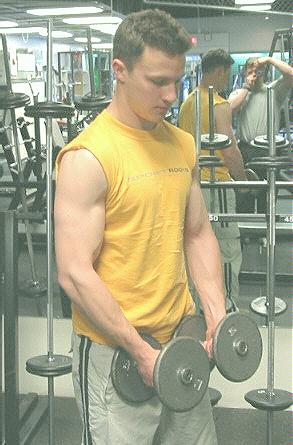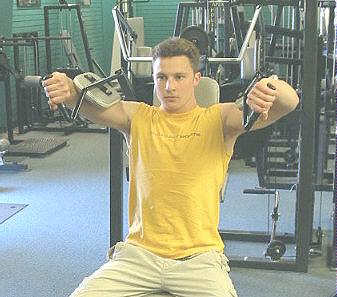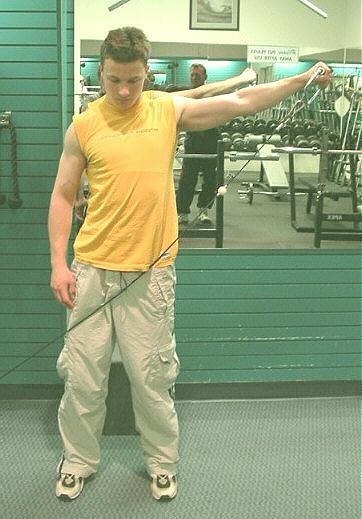|
Shoulder
Training: Foundation / Sport Specific Strength Training Exercises |
| It is important to
warm-up with light weights for a couple of sets using higher reps. I
believe in using 30 reps for the first warm up set, 20 for the second, and
then set of 10 thereafter until I reach my training weight unless
performing high reps sets of 40% (30-40 reps) of 1 RM. This is a muscle
specific warm-up. |
| No. |
Exercise |
Picture: Start |
Picture:
Finish |
Basic
Description |
| A |
Inward Rotation |

|

|
In each of the
following exercises, technique is absolutely critical to avoid injury. You
must pick a weight that is very light. These muscles traditionally do not
get worked very much due to the Gym "push , pull" mentality.
Only when we injury ourselves do we venture out of the "box"
into exercises that will help heal us. Most rotator injuries (aside from
throwing sports) come from over-taxing these muscles by work or by
play.
Perform these
exercises on a bench, on your back.
In the first
exercise position your arm as shown by your side and slowly rotate
your arm outwards until you feel a very "light" stretch and then
rotate back. Breathe out when rotating outwards.
In the second
exercise position arm perpendicular to your body and rotate arm
down and back as shown. Breathe in when rotating back and out when
rotating forward.
In the third
exercise position arm perpendicular to your body and rotate arm
down and back as shown. Breathe in when rotating down and out when
rotating upwards.
In the fourth
exercise position yourself sideways on the bench and arm at a 45
degree angle downwards. Rotate up and back breathing in when raising
weight and out when lowering.
|
| B |
Downward Rotation |

|

|
| C |
Upward Rotation |

|

|
| D |
Backward Rotation |

|

|
| Dumbbell Shoulder
Training Exercises |
| 1 |
Apex Shoulder Press |

|

|
Handles set at above
shoulder height. This is determined by shoulder flexibility. The elbows
must be kept under the bar NOT rotated back. Elbows shown parallel
position. Breathe out on press, in when lowering weight. Keep back against
pad and abs tight. Head erect and square to shoulders. |
| 2 |
Dumb-bell
(DB) Shoulder Press |

|

|
Perform as above.
Elbows under DB, weights balanced. Breathe out on press and in when
returning to start position. Abs tight and back against pad. Feet planted
firm. Head erect and square to shoulders. |
| 3 |
DB Alternate Press |

|

|

|
Perform the same as exercise (2)
except start with palms facing body. Rotate as shown into full press
position. |
| 4 |
DB Forward Lateral Raise |

|

|
Position weights as
shown with hands rotated into front thigh position. Alternately, raise
weight to an "above parallel" position. Inhale when raising
weight. Dumbbells isolate weakness in left to right arm strength.
Can be performed using a bar once weakness corrected. |
| 5 |
DB Side Lateral Raise |

|

|
Position weights as
shown. Inhale raising dumbbells, Keep elbows bent and above wrists as
shown. Parallel-to-floor position shown. Weights can be raised slightly
higher as long as correct form used. |
| 6 |
DB Bent Over Reverse Lateral
Raise |

|

|
Bent over side
laterals work the back of the shoulders. Sitting on the edge of a bench
with back straight, position DBs as shown. Breathing in, bring the DBs up
and back as shown squeezing the back of the shoulders and shoulders blades
together. |
| 7 |
Prone Incline Bench Reverse
Lateral Raise |

|

|
Perform as above
with the exception of using an incline bench. This supports the upper body
and eliminates the "swinging" of the weights upwards through use
of the torso. Keeping the elbows forward and rotating the DBs inwards
helps to isolate the rear delts better. |
| 8 |
Reverse Lateral Raise |

|

|
This is a sport
specific exercise. This is a rear DB lateral raise and is executed as if
taking a slap shot. Lower position as shown with tension on the rear delts.
Inhaling, raise the weight crisply upwards to top position, lower quickly
breathing outwards and then snap back upwards. Perform for sets of 10 reps
to each side. |
| 9 |
Shrugs |

|

|
Grasp dumbbells as
shown. Inhaling, bring weights upwards pulling shoulders towards ears
(hence the term shrug). Hold and lower to slight stretch position. A bar
can be used if desired. I prefer dumbbells due to the fact that the
shoulders keep a "squarer" position. A variation can be used
where DBs are in a frontal position (not shown), shoulders are pulled
upwards and rotated |
| Shoulder
Bar Training Exercises |
| 10 |
Barbell Forward Prone Lateral
Raise |

|

|
This exercise is
performed on an incline bench with arms shoulder width apart. Raise to 45
degree position as shown inhaling when raising weight. |
| 11 |
Smith Machine Upright Rows |

|

|
Upright row using
Smith machine. This isolates upward pulling action and is a basic starting
exercise. Hands "thumb" width apart. Pull upwards keeping elbows
high breathing in when raising weight. Lock elbows into position with
shoulder blades rotating together and down as shown in free weight
exercise below. Lower weight slowly. |
| 12 |
Barbell Upright Row |

|

|
Perform the same as
in Smith Machine exercise. Lock out position with elbows high important.
Dumbbells can be used if wrist strain is felt. Bar forces wrists into a
horizontal position as bar is raised. Dumbbells allow the wrists to rotate
slightly taking away strain. |
| Machine
and Cable Shoulder Exercises |
| 13 |
Apex Side Lateral Raise |

|

|
Apex side lateral
machine isolates the medial delts (side shoulders). Find comfortable
position with pads on the lower side of the elbow/forearms. Inhale when
raising weight. Squeeze shoulders. |
| 14 |
Cable Side Laterals |

|

|
Cable side lateral
raises are great for isolating the medial delts (outside of the shoulder).
Breathe in when raising the weight and out when lowering. Keep the cable
close to the body and try to limit the action of "shoulder to
ear". Force the shoulders to stay down and raise the handle out and
away from the body. When too much weight is used, it is common to
"shrug" the shoulder using too much of the traps. |
| 15 |
Cable Reverse Lateral Flye |

|

|
Using a lower cable
position, grasp handle as shown. Keeping back flat, and weight supported
on one knee, pull handle across and away from the body to a parallel
position as shown breathing inwards when raising weight. |
| 16 |
T-Bar Reverse Pull |

|
Use wide position on
handles. Keep elbows out and rotated slightly forward, chest against the
bench pad. Breathe in when raising weight. |
| More
to come |







































